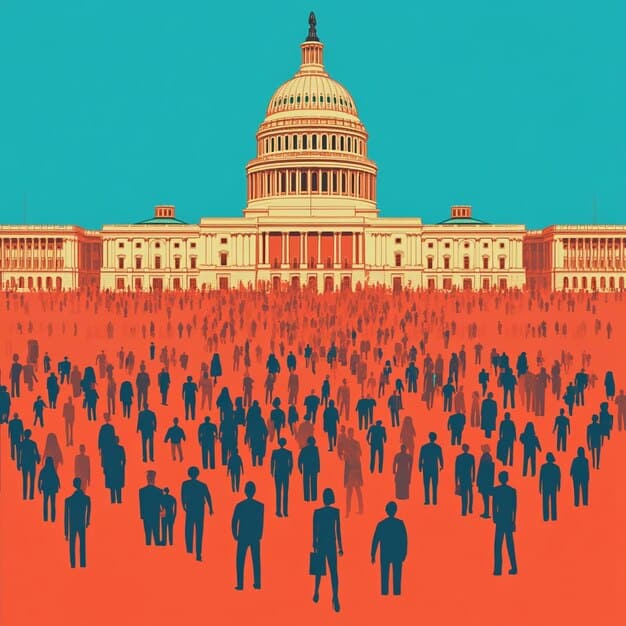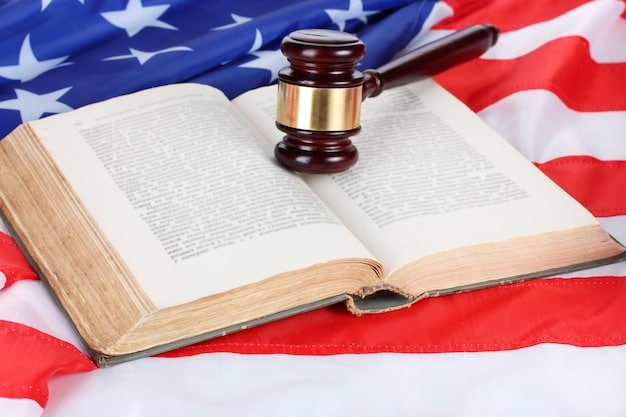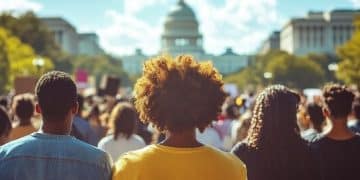Gun Control Debates: How They Impact the Second Amendment

Current debates on gun control legislation could significantly alter the interpretation and application of the Second Amendment, potentially leading to stricter regulations on firearm ownership and usage in the United States.
The Second Amendment of the United States Constitution guarantees the right of the people to keep and bear Arms, but the scope and limitations of this right are continuously debated, especially in light of frequent mass shootings and rising gun violence. How will the current debates on gun control legislation affect the Second Amendment?
Understanding the Second Amendment
The Second Amendment is a cornerstone of American legal and political discourse, yet its interpretation remains a subject of intense debate. A clear understanding of its text and historical context is crucial to grasp the complexities of current gun control debates.
The Text of the Second Amendment
The Second Amendment reads: “A well regulated Militia, being necessary to the security of a free State, the right of the people to keep and bear Arms, shall not be infringed.” This concise statement has been the source of extensive legal and academic discussion.
Historical Context and Intent
Understanding the historical context in which the Second Amendment was framed is vital. It was written in an era where the concept of a standing army was viewed with suspicion, and the idea of a citizen militia was central to defense. The framers’ intent is often debated, with some arguing it was primarily to ensure states had militias, while others believe it guaranteed an individual right to bear arms.
- The amendment was ratified in 1791 as part of the Bill of Rights.
- Its origins can be traced back to English common law and the need for self-defense.
- The debates during the Constitutional Convention reflect varying viewpoints on federal power and individual liberties.
Ultimately, the historical context provides a rich backdrop for interpreting the Second Amendment. However, modern debates often grapple with how to apply these historical perspectives to contemporary issues.
Key Cases Interpreting the Second Amendment
Several landmark Supreme Court cases have shaped the modern understanding of the Second Amendment. These rulings offer crucial insights into how the courts balance the right to bear arms with the government’s power to regulate firearms.
District of Columbia v. Heller (2008)
In District of Columbia v. Heller, the Supreme Court held that the Second Amendment protects an individual’s right to possess firearms for traditionally lawful purposes, such as self-defense in the home. This was a significant affirmation of individual gun rights.
McDonald v. City of Chicago (2010)
McDonald v. City of Chicago extended the Heller decision to the states, ruling that the Second Amendment is incorporated against the states through the Fourteenth Amendment. This meant that state and local governments could not infringe on the right to bear arms.
- These cases established that the Second Amendment protects an individual right to bear arms.
- However, the right is not unlimited and is subject to reasonable restrictions.
- The cases did not define the precise scope of permissible gun control measures.
These rulings have provided a framework for subsequent legal challenges to gun control laws, shaping the landscape of Second Amendment jurisprudence.

Current Gun Control Proposals
In response to ongoing concerns about gun violence, numerous gun control proposals have been introduced at both the federal and state levels. These proposals vary in scope and approach, reflecting the diverse perspectives on how to address gun-related issues.
Universal Background Checks
One of the most widely discussed proposals is universal background checks, which would require all gun sales to go through the National Instant Criminal Background Check System (NICS). This aims to prevent firearms from falling into the hands of individuals prohibited from owning them.
Assault Weapons Bans
Another controversial proposal is the reintroduction of assault weapons bans, which would prohibit the sale and possession of certain types of semi-automatic firearms and high-capacity magazines. Supporters argue this would reduce the potential for mass shootings.
Red Flag Laws
Red flag laws, also known as extreme risk protection orders, allow courts to temporarily remove firearms from individuals deemed a danger to themselves or others. These laws have gained traction as a tool to prevent potential tragedies.
- Universal background checks aim to close loopholes in existing laws.
- Assault weapons bans target firearms perceived as particularly dangerous.
- Red flag laws focus on preventing gun violence on an individual basis.
These proposals represent a range of approaches to gun control, each with potential implications for the Second Amendment.
Arguments For and Against Gun Control
The debate over gun control is characterized by deeply held beliefs and conflicting interpretations of data. Understanding the core arguments on both sides is essential to appreciating the complexity of the issue.
Arguments in Favor of Gun Control
Proponents of gun control argue that stricter regulations are necessary to reduce gun violence and save lives. They point to statistics showing higher rates of gun violence in countries with lax gun laws and argue that certain types of firearms pose an unacceptable risk to public safety.
Arguments Against Gun Control
Opponents of gun control argue that such measures infringe on the Second Amendment rights of law-abiding citizens. They believe that gun ownership is a fundamental right and that restrictions would not deter criminals, who would obtain firearms illegally regardless.
- Gun control advocates emphasize public safety and reducing gun violence.
- Opponents emphasize individual rights and the importance of self-defense.
- Both sides present data and arguments to support their positions.
The clash between these perspectives underscores the challenges of finding common ground in the gun control debate.

Potential Impact on the Second Amendment
The ongoing debates and legislative proposals could have significant implications for the future of the Second Amendment. The courts, legislatures, and public opinion will all play a role in shaping the interpretation and application of this constitutional right.
Narrowing the Scope of the Right
If more restrictive gun control laws are enacted and upheld by the courts, it could narrow the scope of the Second Amendment. This could mean that certain types of firearms are prohibited, and stricter regulations are placed on gun ownership.
Strengthening the Right
Conversely, if legal challenges to gun control laws are successful, it could strengthen the Second Amendment. This could lead to fewer restrictions on gun ownership and greater protection for the right to bear arms.
The impact of current debates hinges on several factors:
- The composition of the Supreme Court and its willingness to revisit Second Amendment precedents.
- The political climate and the ability of lawmakers to pass gun control legislation.
- Public opinion and the influence of advocacy groups on both sides of the issue.
The future of the Second Amendment will depend on how these factors interact in the coming years.
The Role of Public Opinion
Public sentiment plays a key role in shaping the gun control debate. Shifting attitudes and evolving demographics influence both legislative action and judicial interpretation.
Changing Attitudes
Public opinion on gun control has fluctuated over time, often influenced by high-profile mass shootings and broader societal trends. Increased support for stricter gun laws can put pressure on lawmakers to act.
Demographic Shifts
Demographic changes, such as increasing urbanization and diversifying populations, also affect public opinion on gun control. Different demographic groups often hold varying views on gun rights and regulations.
Key ways public opinion impacts the debate:
- Influencing lawmakers to support or oppose gun control legislation.
- Shaping the arguments used by advocacy groups on both sides of the issue.
- Creating a social and political climate that either supports or resists changes to gun laws.
Understanding and responding to public opinion is crucial for policymakers addressing gun control issues.
| Key Point | Brief Description |
|---|---|
| 📜 Second Amendment | Guarantees the right to bear arms, subject to interpretation. |
| ⚖️ Landmark Cases | Heller and McDonald affirmed individual gun rights with restrictions. |
| 🚫 Gun Control Proposals | Include universal background checks, assault weapons bans, and red flag laws. |
| 🗣️ Public Opinion | Influences legislative action and judicial interpretation. |
[Frequently Asked Questions]
▼
The Second Amendment protects the individual right to keep and bear arms, though the extent of this right is debated. It was ratified in 1791 as part of the Bill of Rights.
▼
Heller (2008) affirmed that the Second Amendment protects an individual’s right to possess firearms for traditionally lawful purposes, such as self-defense at home.
▼
Universal background checks require all gun sales to go through the National Instant Criminal Background Check System (NICS) to prevent sales to prohibited individuals.
▼
Assault weapons bans prohibit the sale and possession of certain semi-automatic firearms and high-capacity magazines, aiming to reduce mass shootings.
▼
Red flag laws permit courts to temporarily remove firearms from individuals deemed dangerous to themselves or others, preventing potential violence.
Conclusion
The interplay between gun control debates and the Second Amendment is complex and multifaceted. Current proposals and legal challenges will continue to shape the scope and interpretation of this fundamental right, impacting the balance between individual liberties and public safety in the United States.





